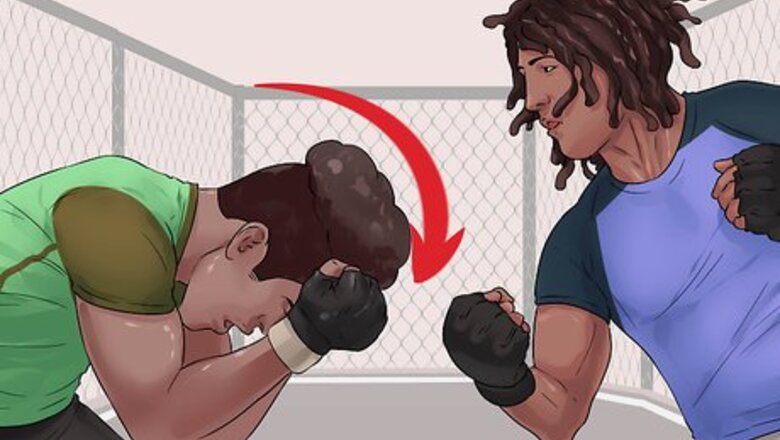
views
Performing the Choke from Standing
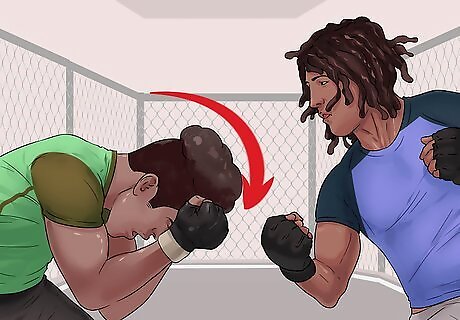
Get your opponent's head down. Wait till your opponent makes a move toward your legs to grab their head. Or if they have their head slightly bent toward you, reach out and pull their head down by clasping your hands behind their neck and pulling down. Get their head at the level of your chest, with their face toward the ground. Wait for any time your opponent comes toward you with their head toward the outside of your body. This is an ideal position for you to perform this choke.

Wrap your arm around their neck. With their head still facing down, wrap one of your arms around the back of your opponent's head. Wrap it all the way around so that your forearm is against their neck. Face the palm of your hand toward your own chest to keep the pressure tight.

Grab your choking arm with the other hand. Grasp the wrist of the arm you have wrapped around your opponent with your other hand. Hold this grip tightly so that your opponent can't remove his head from the bind created by your arms. You can also try a cup-and-saucer grip by making the hand of your choking arm into a fist and grasping that fist with the open palm of your other hand. Another variation is to use a chainlink grip, in which the fingers of each hand are cupped to grasp the other. You can also hold your opponent's back by hooking your arm under theirs to reach the back and grasping your bicep with your choking arm. Or, hold their tricep or trapezius (top of the shoulder) and grasp your own bicep or wrist with your choking arm.
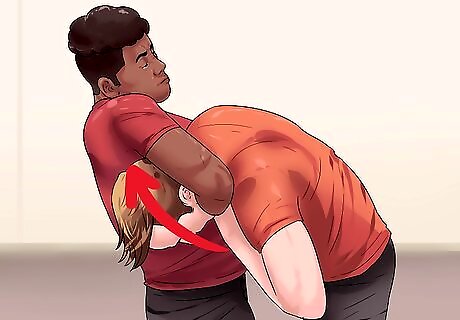
Pull up on the head. Maintain your hold around your opponent's neck and pull up with both hands. Imagine you are trying to stretch your opponent out. Push your hips forward, squeeze your elbows in toward your body, and inhale in order to complete this hold and stretching of your opponent. You may also step forward with one foot and twist your hips in the direction of that foot to trap them in this position.
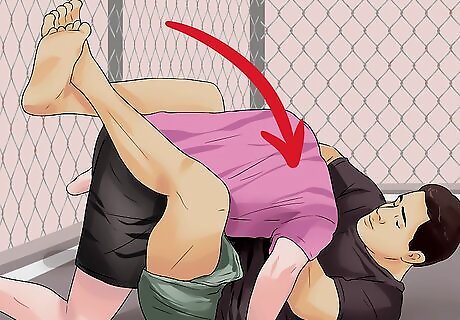
Move the opponent to the ground (optional). To further the choke, sit back onto the ground with the opponent's head still within your choke. Place them in a guard position, meaning that you wrap your legs around your opponent's back as they are on top of you. Pull with your hands and push with your legs, as if you are stretching your opponent out.
Performing the Choke from the Ground

Position yourself to sit up. If you have your opponent on the ground, get them into guard position by wrapping your legs around them when your back is to the ground. Place your feet flat on the ground and put a hand on the ground behind you. Prepare to move your hips back to a sitting position.

Grab the opponent's right wrist. Reach for your opponent's right wrist with your left hand while you still have them in the guard position. Your opponent will attempt to counter this move by placing their right hand behind your back, where you can't reach it. This puts your opponent's head and body closer to you, which is ideal for beginning the choke.
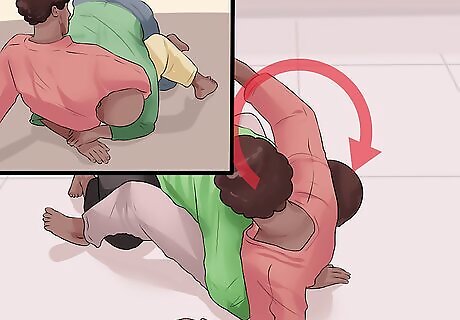
Wrap your right arm around the neck. Pull yourself all the way into a sitting position. Wrap your right arm around the back of your opponent's head and around their neck. Keep your right hand near your stomach to tighten the hold. Also keep your hand out of your opponent's view if possible.
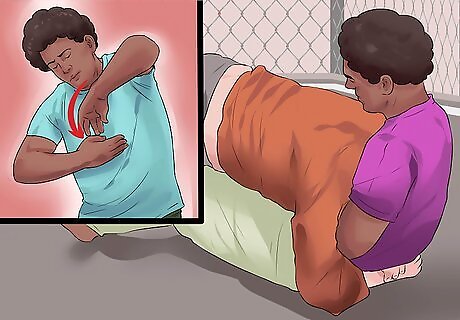
Grasp your right wrist. Put your left hand under your opponent's chin. Use it to grasp your right wrist (your choking arm). Hold this grip tightly so that your opponent cannot escape your arms. For a tighter grasp, try turning your hips and body slightly to the right toward your opponent's head. This should create less space and thus a tighter hold.
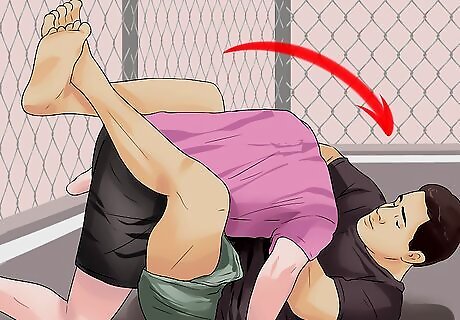
Put your opponent back in guard. Get your opponent back into guard position by wrapping your legs around their midsection. Keep their head in the choke created by your arms. Pull up with your arms and push down with your legs to stretch your opponent and finish the choke.
Using the Choke in Combat
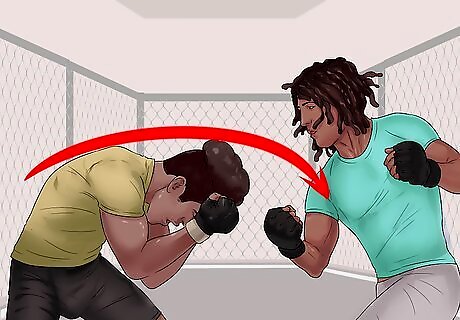
Employ the guillotine choke to force submission. Use the guillotine in jujitsu, other martial arts training, or self-defense when you want to force your opponent into submission. The tight choke forces your opponent to tap out (surrender) or else suffer extreme discomfort or injury. Ideal situations for using this choke are when an opponent lunges toward your legs, when they move to escape from your guard position on the ground, or any other time that their head is low and close enough to your body to position your choking arm behind the neck.
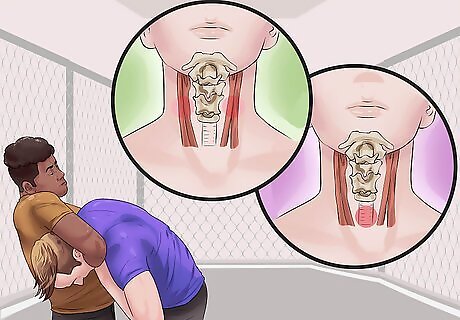
Make this move a blood or air choke. Decide whether you want this choke to constrict your opponent's blood flow, or if you want it to constrict airflow. This change is dependent on the placement of your arm around their neck. For a “blood choke,” make sure to place the radial bone on your inner wrist against your opponent's carotid artery, located at either side of the neck. For an “air choke,” place the full pressure of your forearm against your opponent's windpipe, located at the front of the neck. Both methods will force an opponent into submission, as they will lose consciousness quickly from either suffocation or lack of blood flow.
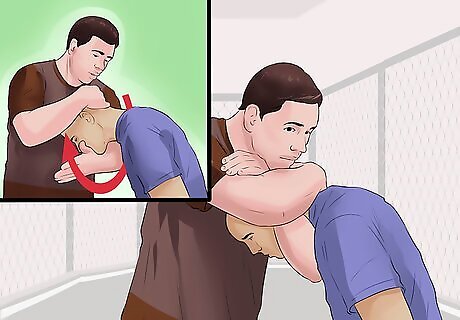
Try a reverse variation. Attempt a variation on the guillotine choke by cupping the back of your opponent's head with one hand. Then place your choking arm underneath their neck. Place the hand of your choking arm on your other bicep, then reach with your non-choking arm toward the opposite shoulder. This method differs from the standard guillotine choke in that your choking arm doesn't wrap from the back around to the front of your opponent's neck, but rather reaches under for the front of the neck directly. Your non-choking arm reaches for the opposite shoulder to create a tight hold. Use this variation any time that you would perform a regular guillotine choke. You may prefer this version if your opponent's head is not close enough or down far enough for you to easily wrap your arm over the neck as in a regular guillotine.

















Comments
0 comment